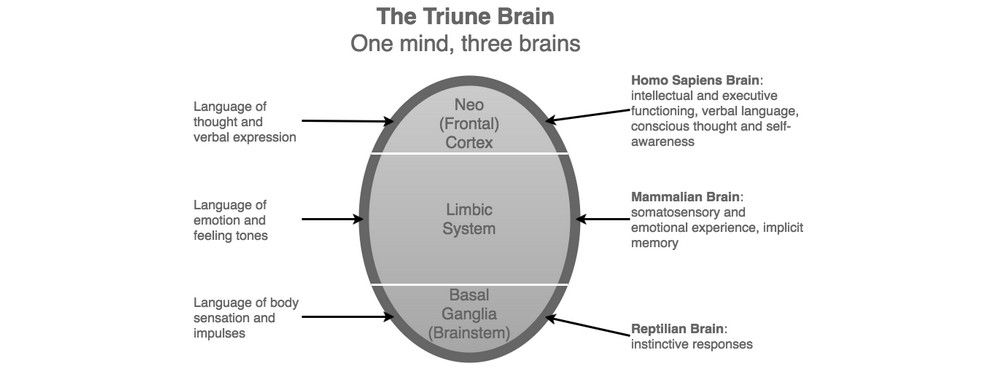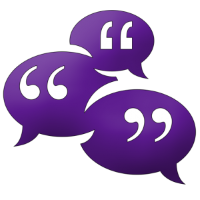
Related Post
The ‘Triune Brain’ theory by Neuroscientist Paul MacLean — an evolutionary perspectiveThe ‘Triune Brain’ theory by Neuroscientist Paul MacLean — an evolutionary perspective

In the 1960s, American neuroscientist Paul MacLean formulated the ‘Triune Brain’ model, which is based on the division of the human brain into three distinct regions. MacLean’s model suggests the human brain is organized into a hierarchy, which itself is based on an evolutionary view of brain development. The three regions are as follows:
- Reptilian or Primal Brain (Basal Ganglia)
- Paleomammalian or Emotional Brain (Limbic System)
- Neomammalian or Rational Brain (Neocortex)
At the most basic level, the brainstem (Primal Brain) helps us identify familiar and unfamiliar things. Familiar things are usually seen as safe and preferable, while unfamiliar things are treated with suspicion until we have assessed them and the context in which they appear. For this reason, designers, advertisers, and anyone else involved in selling products tend to use familiarity as a means of evoking pleasant emotions.
Nature’s Effect On Our Mental HealthNature’s Effect On Our Mental Health
Adapted from Australian Institute of Professional Counsellors, Institute Inbrief, Edition 359.
Good day readers! How are you? … Shit? Depressed? Anxious? Angry? First of all, if you’re someone who says “I feel shit”, I would encourage you to use a more accurate descriptor instead of shit. Tell your brain what emotion or feeling you are experiencing. Shit can mean a lot of things. When we’re able to identify an emotion, it’s more likely we’ll be able to regulate or manage it. When I was learning Dialectical Behavioural Therapy, they had a saying: Name it to claim it to tame it. They also encouraged us to distance our identity from our feelings e.g., “I’m having the feeling that I’m angry” rather than “I’m angry”. I know it sounds like simple fluff but there is a profound difference between observing the experience of anger, loneliness, fear, guilt etc. and believing we (the self) are the embodiment or a manifestation of an emotion.
Alright, moving along to the subject of the article. The Australian Institute of Professional Counsellors sent me their monthly (I think it’s monthly) Institute Inbrief. If you’re someone who has lived with a mental health disorder or emotional difficulties for a long time, being in nature is not really a new antidote from the field. And it’s not always as simple as just going out into nature. When I was deep in the abyss of my own depression, there wasn’t a lot that would change my mood or perception of life. But, we do these practices anyway – and that’s kind of the point. It’s a practice. It may have to be initiated using a bit of self-force. Oftentimes, motivation comes after we begin the motion.
So, here are some examples from the article that support ‘nature has a therapeutic effect for the mind and body’:
- One study found that women who looked at pictures of nature for two minutes had lower levels of the stress hormone cortisol (Gillespie, et al., 2019).
- Another study showed that people who walked in a forest preserve showed lower levels of hostility, aggression and anxiety than they did before the walk.
- Gregory Bratman, PhD, an assistant professor at the University of Washington, and colleagues shared evidence that contact with nature is associated with increases in happiness, subjective well-being, positive affect, positive social interactions and a sense of meaning and purpose in life, as well as decreases in mental distress (Science Advances, Vol. 5, No. 7, 2019).
How can we most effectively reap the mental health benefits that nature offers?
Why nature?
I’m aware we’re in Covid-19 lockdown and restrictions at the moment (27/09/2021) so you will need to determine for yourself if what proceeds to be written is practical and realistic for you right now.
We need to understand that the psyche of the human-being is linked to the natural world in many important ways. The human brain constantly processes and assimilates incoming information, and it relies on external stimuli for guidance regarding how to think and behave. Not only does incorporating nature into our daily lives help us understand the world better, but it can also contextualise ourselves in accordance with this understanding; humans – as an animal – have evolved in tandem with the natural world, and thus it is able to promote the development of beneficial skills including improved visual–spatial acuity, attentional abilities, and memory (Oddie, 2019). Our world is full of beautiful and intricate natural structures, and even just a simple walk through a park can provide us with moments of joy, awe, and wonder (Fiebert et al., 1980; Lefebvre & Brucker, 2018).
Additionally, the seemingly chaotic stimulus that nature provides us with promotes creativity and abstract thought (Berman, et al., 2012); these qualities have been the cornerstone of our species’ evolutionary development over the past few thousand years, thus illustrating the primacy of our relationship with nature.
Our neurobiology is extremely complex, and as such cannot be reduced to simple terms. However, we can say with some certainty that our brains’ sophisticated processing systems are enhanced by our interactions with nature. Our brain naturally integrates external stimuli into existing mental frameworks—this is referred to as “cognitive recursion” (Oddie, 2019). This means that if we spend our time in environments that were designed and created by the human mind, then we are putting ourselves in an echo chamber of stimulus and will not receive new information to broaden our mental capabilities. If we spend time in nature surrounded by structures and patterns that are born of unfathomably complex and foreign processes, then our minds can assimilate this new content into its existing understanding of reality.
Basically, if you spend your days in a white cube (i.e. a house) then your mental framework will be limited to the creative potential that a white cube suggests. If, however, you spend your days in an ever-changing fractal world of colours and shapes (i.e. natural environments) then your mind will reflect this, and adopt an expanded creative potential in order to perceive and understand its surroundings. This is a powerful reality; understanding how our connection with nature nourishes our minds is where spirituality meets both science and intuition.
What benefits does nature offer?
Perhaps the most important and relevant aspect of an active lifestyle in nature is its ability to reduce stress. Studies have shown that taking a walk in a park could decrease stressful thoughts, and even reduce blood pressure (Bush, et al., 2016; Robins, 2020). This finding demonstrates that simply being exposed to nature can decrease stress levels, and implies that returning to nature may be an effective way of keeping our mental health at its best. And here’s the kicker: any amount of time spent in nature is net-gain for your mental wellbeing (Robins, 2020). There is no threshold or minimum a dosage of nature that will have an effect on you – even just spending a short time sitting in your backyard enjoying nature will likely have a positive impact on your mental health.
Other studies have also shown that exposure to nature has an effect on our emotional outlook; particularly in regards to relieving us from pessimistic and fearful thinking (Lefebvre & Brucker, 2018). Life in the modern world is full of consequential decisions and options, the outcomes of which can dictate the quality of your entire life. Decision making is one of the more neurologically complex and taxing processes that our brains undertake, and research has shown that we make 35,000 choices per day (Huston, 2018).
This process involves assessing each option for its individual merit, sorting each option into a hierarchy in relation to every other option, making predictions about every possible positive and negative outcome of each option, and then weighing each outcome against that of every other option; golly, how exhausting! The fear and pessimism arises because each option invariably comes with the potential for myriad negative outcomes, and we are constantly coerced into assessing these. Thankfully, nature offers respite from all this noise. Spending time in nature relieves us from overthinking by presenting us with very few options, each with relatively inconsequential outcomes; ‘where will I sit while I drink from my water bottle?’ or ‘should I take the path leading towards the lookout, or the waterfall?’ are not taxing decisions to make, and will not prompt fearful or pessimistic thought patterns. There is an easiness to natural environments in which things seem to flow along their own course, and we are able to simply jump into the stream and flow along with it.
Aside from experiential benefits, time in nature can help us orient ourselves in the world in more grounded and productive ways. In today’s society, our attentional abilities are sapped by large corporations who profit from our distractibility, and it seems as though a way to remedy this mental breach is routine contact with nature. Attentional abilities are bolstered by spending time in nature (Ebata & Izenstark, 2017), making you less susceptible to the temptations of modernity (i.e. problematic social media scrolling, binging streaming services, etc).
Thus, making time in nature a priority in our lives – especially when we do not even feel stressed or anxious – can help us orient ourselves to the world around us and find a sense of personal empowerment. Taking time to be immersed in nature can help us regain confidence, ground us in a personal sense of meaning, and re-establish our wellbeing. Being in nature is correlated with increased positive emotions and feelings of control over one’s life (Chowdhurry, 2021), so even if we do not believe we need some sort of mental intervention, the benefits are there for everybody to experience.
How can I fit more nature-time into my life?
For the most part, we only need to reflect on our daily behaviours to see how we can incorporate time in nature into our lives. James Clear, in his wildly popular book Atomic Habits (2018), suggests incorporating a “budding habit” into an existing habit.
So for instance, if you have a lunch break during the work day, you could spend it outside on a park bench instead of in the staff room. If you come home at the end of the day and like to sit on the couch with a book, go outside and sit on the grass instead. These are simply ways to adopt more nature-time into your life, without having to add another separate activity to your schedule. In a 2017 study (Austin, et al., 2017), some participants were asked to take a brief walk in nature once per day, and other participants weren’t. The results showed that those who walked daily had higher levels of positive emotions and well-being than those who walked less. It doesn’t take a lot of time to nourish our minds in the deep ways that only nature offers us, and it seems to be a worthwhile habit to form.
Making the time to experience nature is easy to ignore in lieu of more ‘important’ tasks. That walk in the park you planned on taking this afternoon suddenly seems overshadowed by a looming deadline or a sink full of dirty dishes. For this reason, it can be beneficial to keep yourself accountable by planning nature-time with other people. Planning to go for a walk with friends means there is a lower likelihood of cancelling. Better yet, if you can join a weekly community group or class of some sort then you won’t even have to continually plan your time in nature.
There are volunteer groups who aid revegetation in nature reserves, there are community gardens who need people to tend to plants and crops, and there are clean up groups who dispose of discarded rubbish in bush-lands. If volunteering isn’t appealing to you, then you could change your routine by canceling your gym membership in lieu of outdoor exercise classes or yoga, or even new activities like cycling or rowing. Making scheduled appointments to spend time in nature can assist those who have trouble achieving this with sheer willpower, and your mental health will thank you for it.
Our acknowledgment of the value of time spent in nature is growing each day, which is why more urban living environments are incorporating ‘green spaces’ into their design. Using the latest neuroscience research, we are able to determine which types of natural environments compliments our mental states the most effectively. For example, it has been found that areas with high levels of biodiversity can alleviate symptoms of anxiety and depressions more-so than those with low levels of biodiversity (Wyles, et al., 2019). Similarly, people who watched videos featuring a diverse array of flora and fauna reported lower anxiety and higher vitality than those who watched videos of less biodiverse landscapes (Wolf, et al., 2017).
Findings like these offer valuable insight into how we can engineer our surroundings to best facilitate the highest levels of wellbeing possible. It is clear that spending time in nature is invaluable for our mental health, but a half-hour lunch break doesn’t give us time to go hiking through a biodiverse mountain landscape; what we can do, however, is have access to green spaces which replicate the stimulus that we would receive if we were in nature. This has proven to be an eloquent solution to the pressing issue of depression rates in urban CBD areas (Ebata & Izenstark, 2017).
Summary
In conclusion, the role of nature in our lives is of paramount importance to our health and should be a priority for us all. Although it may feel like adding a daily walk outside to our schedules would be in futility, the positive mental health benefits outweigh the costs significantly. Making time in nature a priority, no matter how little, can greatly increase our overall sense of wellbeing, and remind us that we are interconnected to the living world around us.
There is no minimum threshold required to reap the benefits of nature, so we can all find a way to capitalise on just a little bit of time in natural environments. As a species, it is our natural disposition to enjoy the outdoors, and the benefits are more abundant than you might expect. So pop on a pair of joggers, Google search ‘hikes near me’, phone a friend, and get out there amongst the fresh air; you can thank us later!
References:
- Berman, M. G., Kross, E., Krpan, K. M., Askren, M. K., Burson, A., Deldin, P. J., . . . Jonides, J. (2012, November). Interacting with nature improves cognition and affect for individuals with depression. Retrieved from: Website.
- Bush, R., Dean, J., Lin, B., & Fuller, R. (2016). Health Benefits from Nature Experiences Depend on Dose. Scientific Reports.
- Chowdhury, M. (2021, February 19). The Positive Effects Of Nature On Your Mental Well-Being. Retrieved from: Website.
- Clear, J. (2018). Atomic habits: An easy and proven way to build good habits and break bad ones. London: RH Business Books.
- Hunter, M. R., Gillespie, B. W., & Chen, S. Y. (2019, March 15). Urban Nature Experiences Reduce Stress in the Context of Daily Life Based on Salivary Biomarkers. Retrieved from: Website.
- Huston, M. (2018). How Many Decisions Do We Make Each Day? Retrieved from: Website.
- Izenstark, D., & Ebata, A. (2017). The Effects of the Natural Environment on Attention and Family Cohesion: An Experimental Study. Children, Youth, and Environments.
- Wyles, K. J., White, M. P., Hattam, C., Pahl, S., King, H., & Austen, M. (2017). Are Some Natural Environments More Psychologically Beneficial Than Others? The Importance of Type and Quality on Connectedness to Nature and Psychological Restoration. Environment and Behavior, 51(2), 111-143. doi:10.1177/0013916517738312

